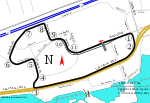Coca-Cola Coliseum

Coca-Cola Coliseum (French: Colisée Coca-Cola) is an arena at Exhibition Place in Toronto, Ontario, Canada, used for agricultural displays, ice hockey, and trade shows. It was built for the Canadian National Exhibition (CNE) and the Royal Agricultural Winter Fair (the Royal) in 1921. Commonly known as the Coliseum, it was formerly known as the CNE Coliseum and Ricoh Coliseum, and since 1997 it has been part of the Enercare Centre exhibition complex. It serves as the home arena of the Toronto Marlies ice hockey team, the American Hockey League farm team of the Toronto Maple Leafs. For the 2015 Pan American Games the venue hosted the gymnastics competitions and was known as the Toronto Coliseum.
Excerpt from the Wikipedia article Coca-Cola Coliseum (License: CC BY-SA 3.0, Authors, Images).Coca-Cola Coliseum
Gardiner Expressway, Toronto
Geographical coordinates (GPS) Address Website External links Nearby Places Show on map
Geographical coordinates (GPS)
| Latitude | Longitude |
|---|---|
| N 43.635833333333 ° | E -79.415 ° |
Address
Coca-Cola Coliseum (Coliseum)
Gardiner Expressway
M5V 0C8 Toronto
Ontario, Canada
Open on Google Maps





